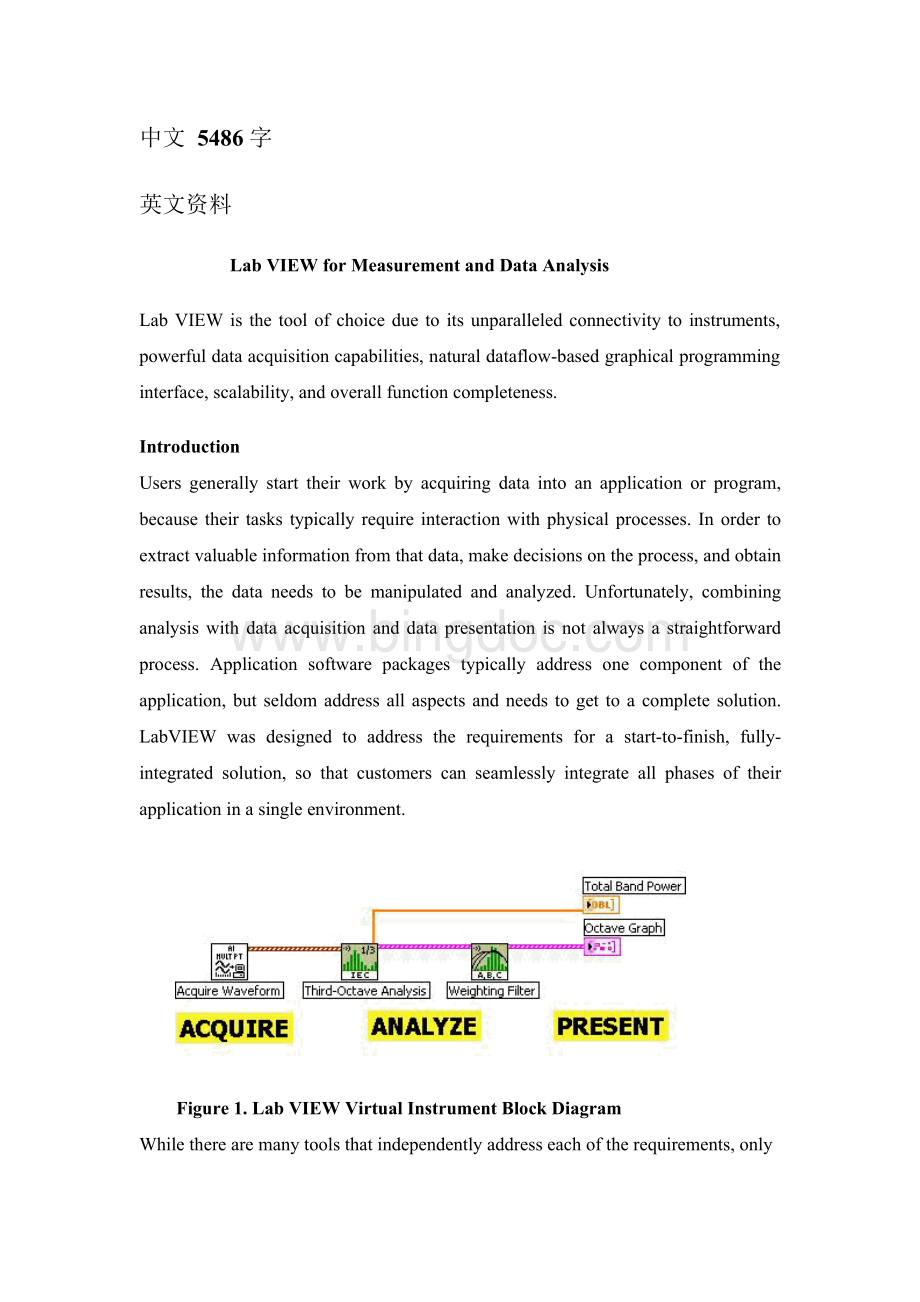外文翻译---LabVIEW的测量和数据分析.docx
《外文翻译---LabVIEW的测量和数据分析.docx》由会员分享,可在线阅读,更多相关《外文翻译---LabVIEW的测量和数据分析.docx(20页珍藏版)》请在冰点文库上搜索。

中文5486字英文资料
LabVIEWforMeasurementandDataAnalysis
LabVIEWisthetoolofchoiceduetoitsunparalleledconnectivitytoinstruments,powerfuldataacquisitioncapabilities,naturaldataflow-basedgraphicalprogramminginterface,scalability,andoverallfunctioncompleteness.
Introduction
Usersgenerallystarttheirworkbyacquiringdataintoanapplicationorprogram,becausetheirtaskstypicallyrequireinteractionwithphysicalprocesses.Inordertoextractvaluableinformationfromthatdata,makedecisionsontheprocess,andobtainresults,thedataneedstobemanipulatedandanalyzed.Unfortunately,combininganalysiswithdataacquisitionanddatapresentationisnotalwaysastraightforwardprocess.Applicationsoftwarepackagestypicallyaddressonecomponentoftheapplication,butseldomaddressallaspectsandneedstogettoacompletesolution.LabVIEWwasdesignedtoaddresstherequirementsforastart-to-finish,fully-integratedsolution,sothatcustomerscanseamlesslyintegrateallphasesoftheirapplicationinasingleenvironment.
Figure1.LabVIEWVirtualInstrumentBlockDiagram
Whiletherearemanytoolsthatindependentlyaddresseachoftherequirements,only
LabVIEWcombinesallofthemwiththepowerofgraphicalprogrammingandstate-of-the-artdataacquisitionhardware,usingthepowerofyourPC.Itisthecombinationofdataacquisition,dataanalysis,andpresentationofresults,thattrulymaximizesthepowerofVirtualInstrumentation.Avirtualinstrumentconsistsofanindustry-standardcomputerorworkstationequippedwithpowerfulapplicationsoftware,cost-effectivehardwaresuchasplug-inboards,anddriversoftware,whichtogetherperformthefunctionsoftraditionalinstruments.ThisiswhyapplicationsandprogramsbuiltwithLabVIEWarereferredtoasVI(virtualinstruments).
Asanengineering-focusedtool,LabVIEWmakeshundredsofanalysisfunctionsavailableforresearchers,scientists,andengineers,aswellasstudentsandprofessors.Theycanbuildthesefunctionsrightintotheirapplicationstomakeintelligentmeasurementsandobtainresultsfaster.
ChoosingtheCorrectMethodforAnalysis
Usersincorporateanalysisintotheirapplicationsandprogramsindifferentways.Therearecertainconsiderationsthathelpdeterminethewayinwhichanalysisshouldbeperformed.
Inlinevs.Offlineanalysis
Inlineanalysisimpliesthatthedataisanalyzedwithinthesameapplicationwhereitisacquired.Thisisgenerallythecasewhendealingwithapplicationswheredecisionshavetobemadeduringruntimeandtheresultshavedirectconsequencesontheprocess,typicallythroughthechangingofparametersorexecutingofactions.Thisistypicallythecaseincontrolapplications.Whendealingwithinlineanalysis,itisimportanttoconsidertheamountofdataacquiredandtheparticularanalysisroutinesthatareperformedonthatdata.Aproperbalancemustbefoundbecausetheycouldeasilybecomecomputationallyintensiveandhaveanadverseeffectontheperformanceoftheapplication.
Otherexamplesforinlineanalysisareapplicationswheretheparametersofthemeasurementneedtobeadaptedtothecharacteristicsofthemeasuredsignal.Onecaseiswhereoneormoresignalsneedtobelogged,butthesechangeveryslowlyexceptforsuddenburstsofhigh-speedactivity.Inordertoreducetheamountofdata
logged,theapplicationwouldhavetoquicklyrecognizetheneedforahighersamplingrate,andreduceitwhentheburstisover.Bymeasuringandanalyzingcertainaspectsofthesignalstheapplicationcanadapttothecircumstancesandenabletheappropriateexecutionparameters.Althoughthisisonlyoneexample,therearethousandsofapplicationswhereacertaindegreeofintelligence-theabilitytomakedecisionsbasedonvariousconditions-andadaptabilityarerequired,whichcanonlybeprovidedbyaddinganalysisalgorithmstotheapplication.
Decisionsbasedonacquireddataarenotalwaysmadeinanautomatedmanner.Veryfrequently,thoseinvolvedwiththeprocessneedtomonitortheexecutionanddeterminewhetheritisperformingasexpectedorifoneormorevariablesneedtobeadjusted.Althoughitisnotuncommonforuserstologdata,extractitfromafileordatabaseandthenanalyzeitofflineto modifytheprocess,manytimesthechangesneedtohappenduringruntime.Inthesecases,theapplicationmusthandlethedatacomingfromtheprocess,andthenmanipulate,simplify,format,andpresentthedatainawaythatitismostusefultotheuser.LabVIEWuserscanthentakeadvantageofthemanyvisualizationobjectstopresentthatdatainthemostconciseandusefulmanner.
LabVIEWoffersanalysisandmathematicalroutinesthatnativelyworktogetherwithdataacquisitionfunctionsanddisplaycapabilities,sothattheycanbeeasilybuiltintoany application. In addition, Lab VIEW offers analysisroutines forpoint-by-pointexecution;theseroutinesaredesignedspecificallytomeettheneedsofinlineanalysisinreal-timeapplications.Usersshouldconsidercertainaspectswhendecidingwhetherpoint-by-pointroutinesareappropriate.
Point-by-pointanalysisisessentialwhendealingwithcontrolprocesseswherehigh-speed,deterministic,point-by-pointdataacquisitionispresent.Anytimeresourcesarededicatedtoreal-timedataacquisition,point-by-pointanalysisbecomesanecessityasacquisitionratesandcontrolloopsareincreasedbyordersofmagnitude.Thepoint-by-pointapproachsimplifiesthedesign,implementation,andtestingprocess,becausetheflowoftheapplicationcloselymatchesthenaturalflowofthereal-world processes that the application is monitoring and controlling.
Figure2.Array-basedAnalysisvs.Point-by-PointAnalysis
Real-timedataacquisitionandanalysiscontinuetodemandmorestreamlinedandstableapplications.Point-by-pointanalysisisstreamlinedandstable,becauseittiesdirectlyintothe acquisitionandanalysisprocess.Withstreamlined,stablepoint-by-pointanalysis,theacquisitionandanalysisprocesscanmoveclosertothepointofcontrolinFPGA(fieldprogrammablegatearray)chips,DSPchips,embeddedcontrollers,dedicatedCPUs,andAsics.
Tobetterunderstandtheadvantagesofpoint-by-pointanalysisroutines,NationalInstrumentssuggestsreadingthedocumenttitled"GettingStartedwithLabVIEWPoint-By-PointVIs."
ThisdocumentdescribeshowtousetheVIandincludesacasestudythat showsacompleteapplicationbuiltinLabVIEW.Theapplicationdemonstratesthesimplicityandflexibilityofpoint-by-pointanalysis.
Byaddingthesepowerfulalgorithmsandroutinesintoapplications,userseliminatetheguessworkandcreateintelligentprocessesthatcananalyzeresultsduringruntime,improvingefficiencyanditerativelycorrelatinginputvariablestoexperimentorprocessperformance.
Offlineapplicationsdon’ttypicallyhavethedemandforresultstobeobtainedinreal-timefashioninordertomakedecisionsontheprocess.Offlineanalysisapplicationsrequireonlythatsufficientcomputationalresourcesareavailable.Themainintentofsuchapplicationsistoidentifycauseandeffectofvariablesaffectingaprocessbycorrelatingmultipledatasets.Theseapplicationsgenerallyrequire
importingdatafromcustombinaryorASCIIfilesandcommercialdatabasessuchasOracle,Access,andotherQL/ODBC-enableddatabases.OncethedataisimportedintoLabVIEW,usersperformseveralorhundredsofavailableanalysisroutines,manipulatethedata,andarrangeitin aspecificformatforreportingpurposes.LabVIEWprovidesfunctionstoaccessanytypeoffileformatanddatabase,seamlesslyconnecttopowerfulreportingtoolssuchasNIDiademandtheReportGenerationToolkitforMicrosoftOffice,andexecutethelatestdata-sharingtechnologiessuchasXML,Web-enableddatapresentation,andActiveX.
Programmaticvs.InteractiveAnalysis
AsLabVIEWusers,scientistsandengineersareveryfamiliarwiththemanywaysinwhichtheycanacquiredatafromhundredsofdevices.Theybuildintelligenceintotheirapplicationstoperforminlineanalysisandpresentresultswhiletheapplicationsarerunning.Inaddition,theyareawarethatacquiringdataandprocessingitforthesakeofonlinevisualizationisnotenough.Userstypicallystorehundredsorthousandsofmegabytesofdatainharddrivesanddatabases.Afteranywherefromonetohundredsofrunsoftheapplication,usersproceedtoextractinformationinordertomakedecisions,compareresults,andmakeappropriatechangestotheprocess,untilthedesiredresultsareachieved.。
Itisrelativelyeasytoacquireamountsofdatasolargethatitrapidlybecomes
unmanageable.Infact,withafastDAQboardandenoughchannels,itmayonlytakeafewmillisecondstocompilethousandsofvalues.Itisnotatrivialtasktomakesenseoutofallthatdata.Engineers andscientistsaretypicallyexpectedto presentreports,creategraphs,andultimatelycorroborateanyassessmentsandconclusionswithempiricaldata.Withouttherighttools,thiscaneasilybecomeadauntingtask,resultinginlostproductivity.
Inordertosimplifytheprocessofanalyzingmeasurements,LabVIEWprogrammerscreateapplicationsthatprovidedialogsandinterfacesthatotherscanusesothatdependingontheirinput,specificanalysisroutinesareperformedonanygivendataset.Bybuildingthistypeofapplication,usersbuildacertaindegreeofinteractivityintotheirapplications.Forthistobeefficient,theprogrammermusthaveextensive
knowledgeabouttheinformationandthetypesofanalysisinwhichtheuserisinterested.
Figure3.TimeDomainReflectionVIBasedonJointTime-FrequencyAnalysisF